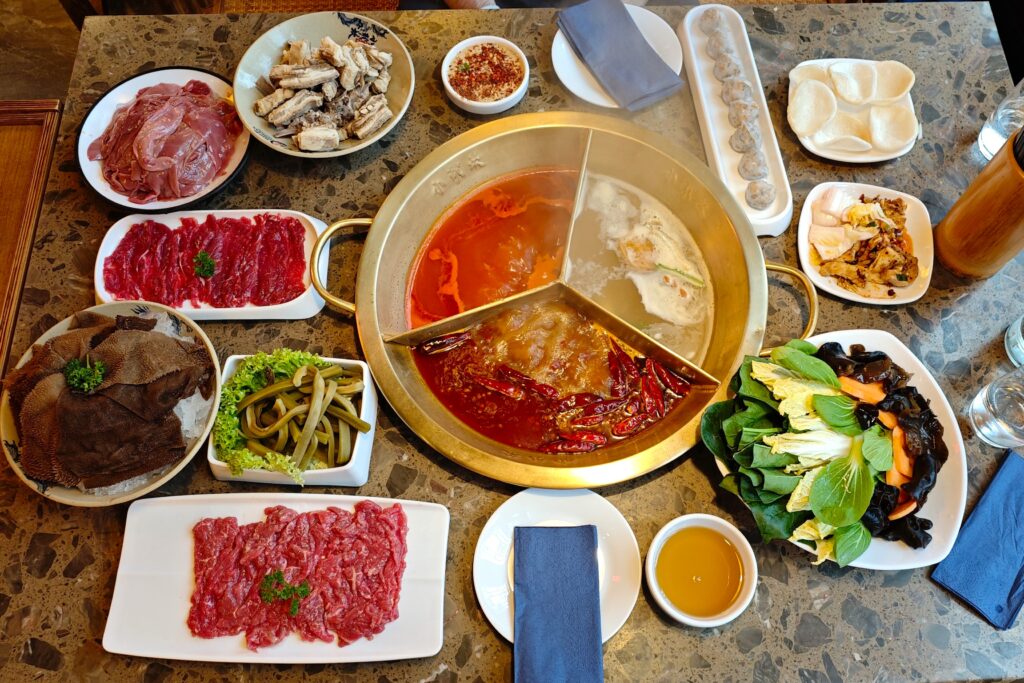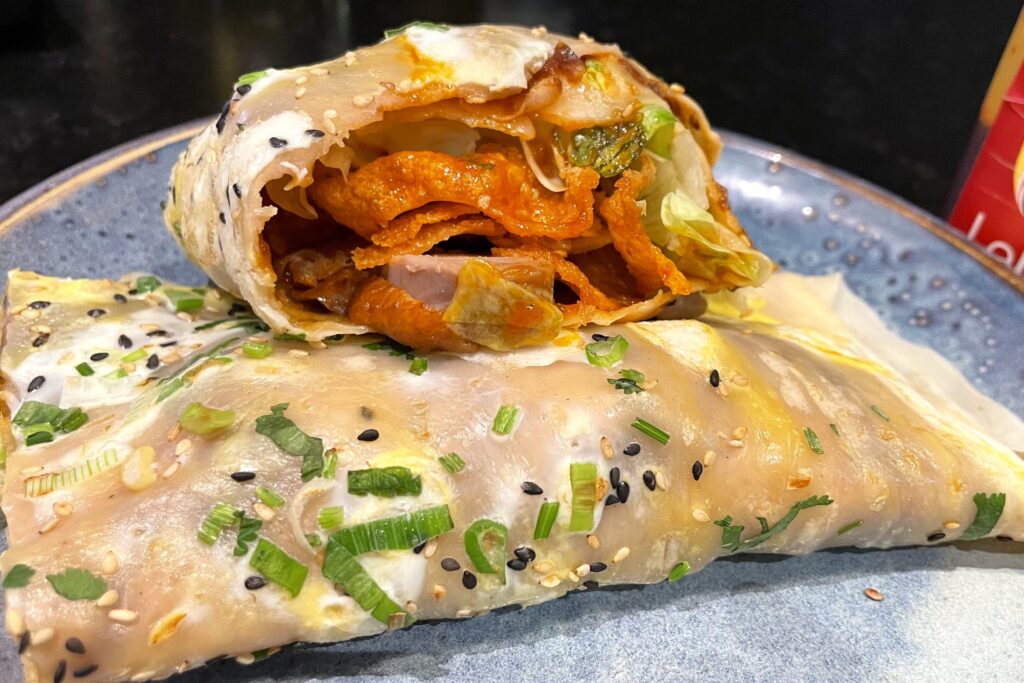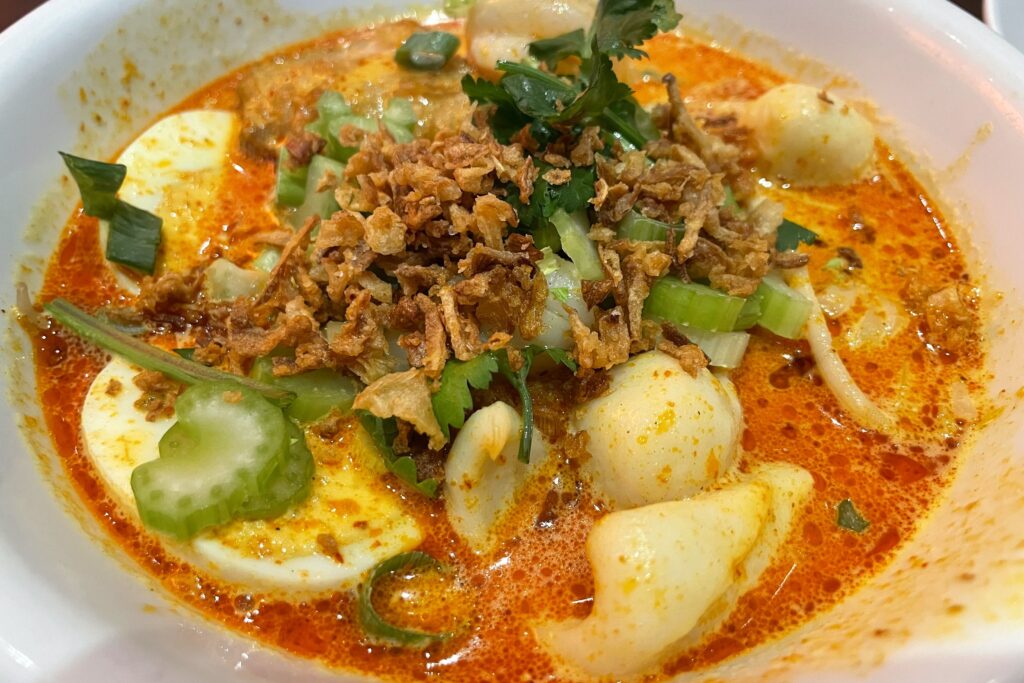Today, we’d like to introduce you to a restaurant that many of you might already know: XiaoLongKan, a well-known hot pot chain originating from Sichuan, China.
The restaurant’s classic Chinese wooden furniture is beautifully crafted from dark, polished wood. On the walls, you’ll find traditional Chinese paintings of natural landscapes and historical figures astride horses. The intricate carvings of 祥云 (auspicious clouds) – a symbol of fortune and harmony – add another layer of tradition and authenticity to the surroundings.
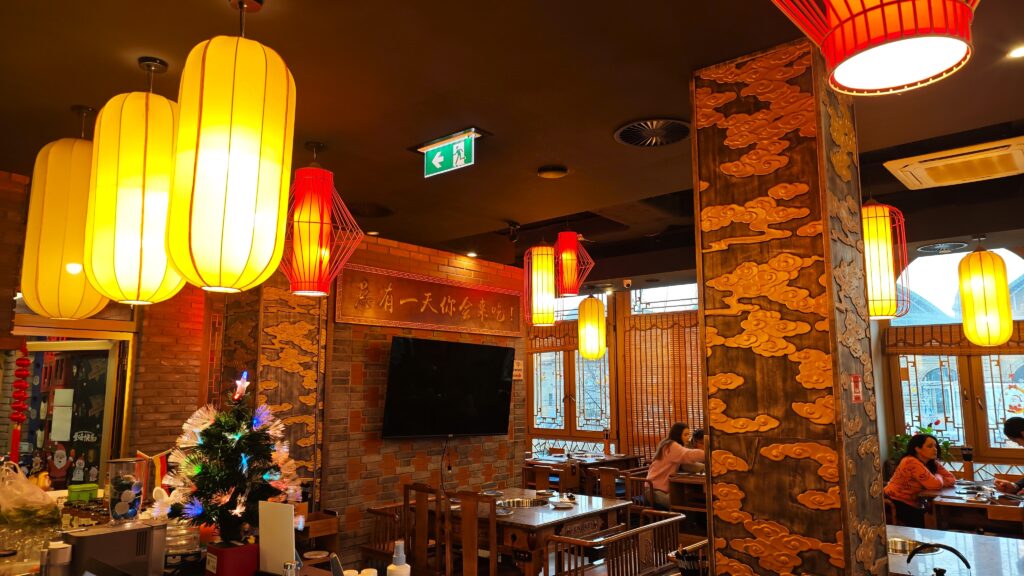
Lanterns glow softly over wooden tables, which are equipped with built-in electric stoves for easy heat adjustment. Many chairs have plush cushions for comfort. XiaoLongKan has various seating options, from two- and four-person tables to spacious private rooms for groups of ten or more.

Having dined here a few times before, I wasn’t immediately hooked, but my European friends couldn’t stop raving about it as their favorite hot pot chain in Europe. Curious to see if we had missed something, we decided to revisit with fresh eyes (and taste buds). This time, we carefully checked their menu, consulted with staff, and picked out some dishes and soup bases that we can wholeheartedly recommend.
Restaurant Profile
🏷️ Name of the Restaurant: XiaoLongKan Hotpot Restaurant (incl. menu)
📍 Adress: Kaiserstraße 81, 60329 Frankfurt am Main
🍜 Style: Chinese Hotpot
💰 Price: around 35 – 75 EUR per Person (incl. drinks)
XiaoLongKan offers various soup bases: for individual diners, small personal pots are available, while groups can choose from single, double, or triple soup bases (三锅底). For those who love trying different flavors, the 三锅底 is the way to go—it’s versatile and the price difference is minimal.
Soup bases include tomato soup base, mala spicy, sour soup, mushroom soup, pork bone soup base. Among them, our favorites are tomato soup base, Sichuan mala spicy soup, and pork bone soup base.
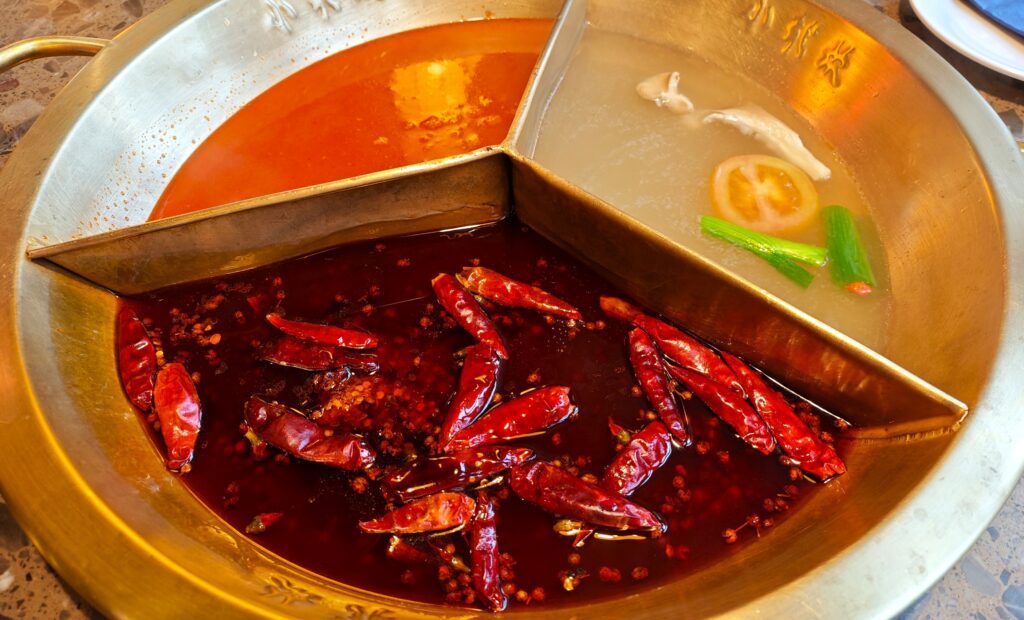
The Tomato Soup base is ideal for those who prefer a fresh, light, fruity flavor. The red broth is bursting with the natural flavor of ripe tomatoes. It’s tangy, sweet, aromatic, and versatile with various ingredients. It’s also nutritious, packed with vitamin C and lycopene, and healthier as it’s low in calories and not greasy.
The Sichuan Mala (麻辣) hot pot base is the most authentic choice and a must-try for spice lovers. This iconic soup base showcases the bold, layered flavors of Sichuan cuisine, combining the numbing spice of Sichuan peppercorns with the fiery heat of dried chilies. The 牛油 (beef tallow) gives the broth a buttery richness and a smooth, mouth-coating quality, while balancing the intense spices with a deep umami note.
The Mala base also includes garlic, ginger, and a hint of star anise, creating a complex flavor that is spicy and aromatic, with an addictive, tingling sensation from the peppercorns. Spice levels can be customized with three options: mild, medium, or spicy. While the spiciest level here isn’t as fiery as authentic Sichuan hot pots, it still delivers a robust kick for spice lovers without overwhelming first-timers.
The Pork Bone Soup base is a classic option for those who love wholesome, hearty and savory flavors. Made by simmering pork bones for hours, this broth tastes rich and meaty without relying on MSG or artificial additives. The milky-white soup has a smooth, velvety texture and a natural umami taste that provides a comforting base for all hot pot ingredients. It’s particularly good for balancing out stronger-flavored bases like mala.
Now here comes the dipping sauce. XiaoLongKan offers a variety of ingredients to mix and match – from crushed peanuts to chili oil, soy sauce, oyster sauce, shacha sauce (沙茶酱), savory, umami and slightly sweet), fresh chili, cilantro, green onions, sesame oil, garlic, and sesame paste.
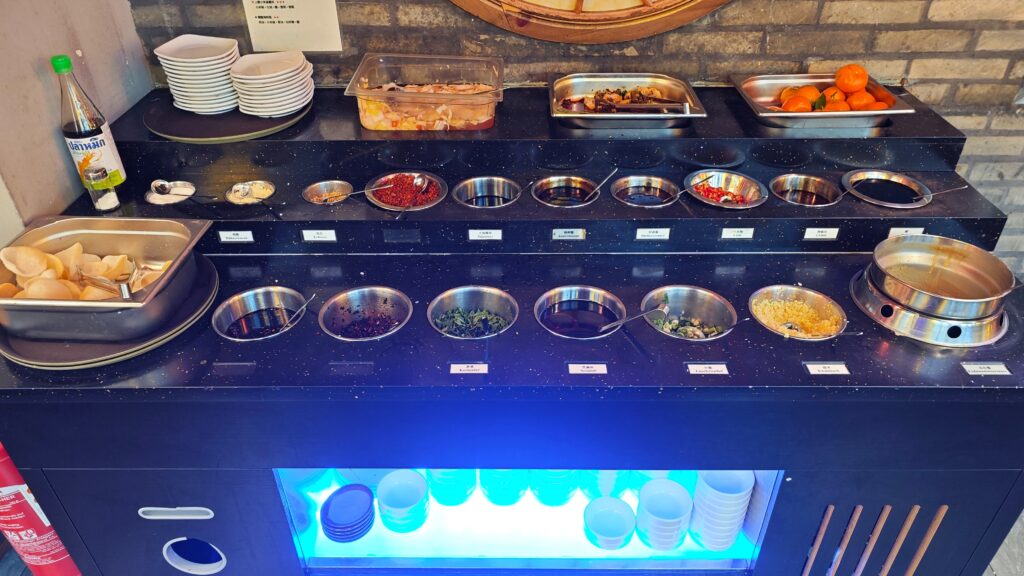
One of our favorite blends follows a Northeastern Chinese style, combining sesame paste, cilantro, garlic, green onions, crushed peanuts, a touch of sesame oil, and chili paste. If you like extra heat, a few fresh chilies will do the trick. This sauce is rich, nutty, and aromatic, mixing savory, creamy, and slightly spicy flavors. It also helps neutralize the heat from the Mala broth.
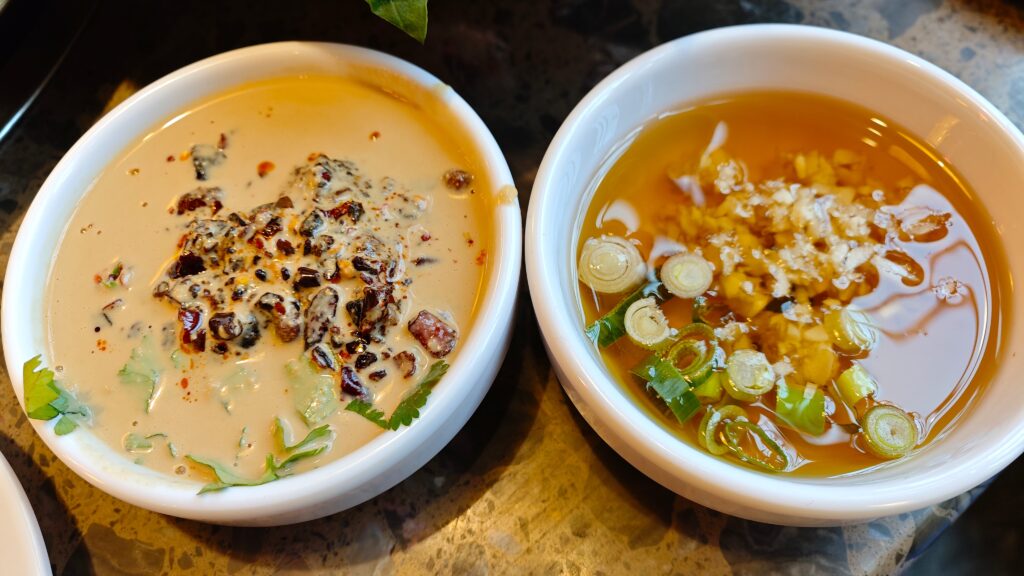
A more Sichuan-style dipping sauce takes a minimalist approach: just sesame oil, garlic, and green onions, with optional cilantro. Surprisingly simple, yet incredibly effective, this mixture highlights the original flavors of the hot pot broth while adding a fresh, fragrant touch. The sesame oil acts as a thin barrier between the broth’s chili oil and the ingredients, preventing excessive spice and oil absorption. In Sichuan, many locals prefer this dip of pure sesame oil with garlic, as it keeps the flavor clean and tempers the intense heat from the Mala broth.
Personally, we like to alternate between the two—one for a smooth, rich contrast and the other for a more authentic Sichuan experience.
XiaoLongKan also offers complimentary appetizers—a little treat while you wait for your hot pot feast to arrive. As soon as you place your order via the tablet menu, which is available in German, English, and Chinese, you can help yourself to a plate of crispy shrimp chips (虾片) or Koushuiji (口水鸡, “Mouthwatering Chicken”), along with fresh oranges.
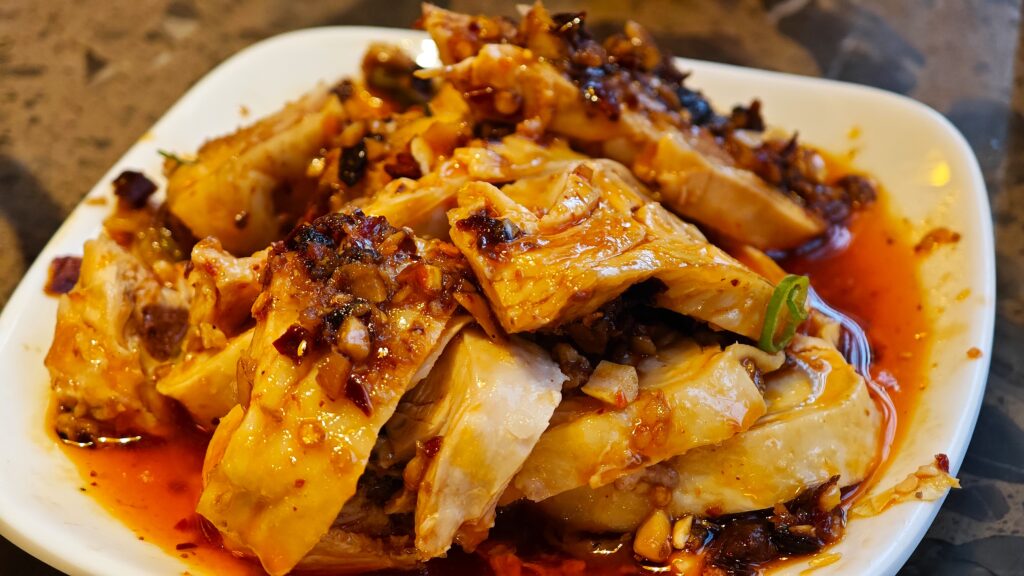
This Koushuiji, a cold Sichuan-style poached chicken, features tender, succulent chicken drenched in a spicy, aromatic chili sauce infused with Sichuan peppercorns, garlic, soy sauce, vinegar, and sesame seeds. The first bite hits with a bold, numbing sensation (麻) from the Sichuan peppercorns, followed by a deep, savory umami, a hint of sweetness and a subtle tangy kick. It’s really an irresistible appetizer.
The airy shrimp chips are a classic Chinese snack—crispy, slightly salty, with a subtle seafood aroma.
With a straightforward ordering process —where you select your broth first and then choose from categories like vegetables, meat, seafood, and carbs – your hotpot experience now officially begins.
Our first highlight is the Freshly Sliced Diao Long (鲜切吊龙), especially for beef lovers.
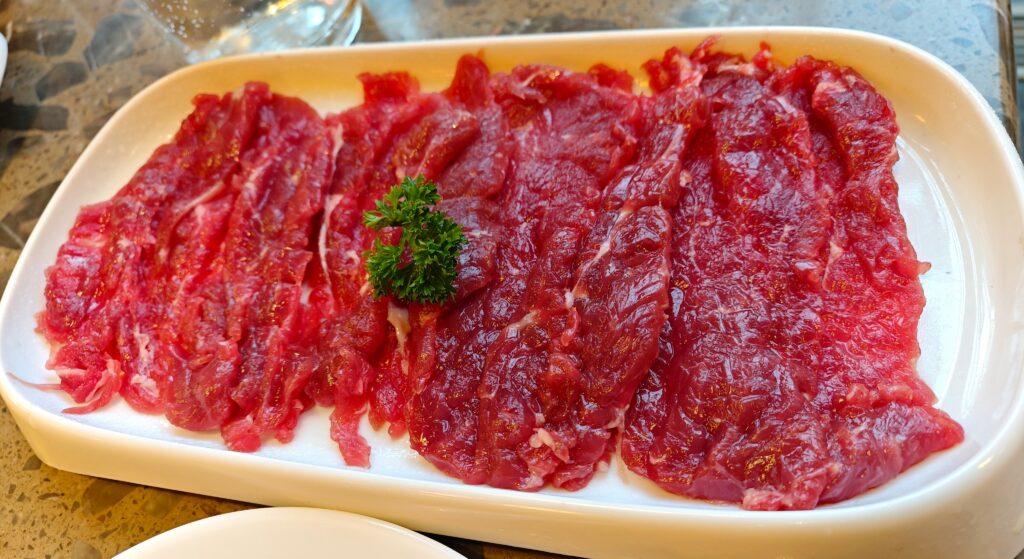
Diao Long (吊龙) is a prized cut from the eye of round, located in the upper rear leg of the cow. Known for its lean texture with minimal fat, this cute offers an intensely robust, beefy flavor without excessive marbling. It has a satisfyingly firm bite but remains tender when cooked properly.
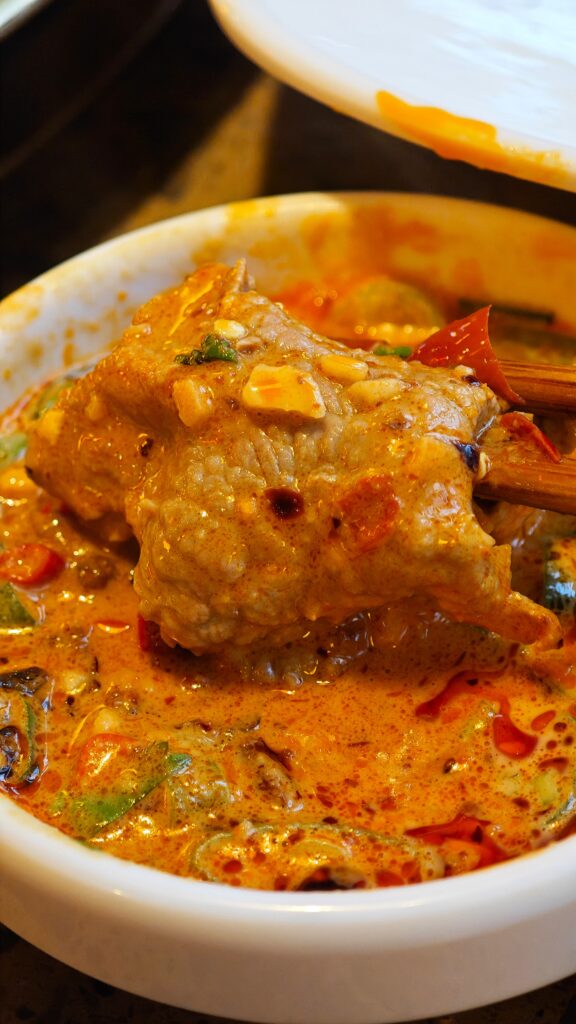
It pairs beautifully with all three broth options: the light yet flavorful tomato broth infuses the beef with a rich, tangy-sweet aroma that enhances its natural savoriness. The Pork Bone Broth adds a silky, meaty depth, while Mala Spicy Broth (our go-to choice for Diao Long!) creates a numbing, fiery flavor explosion. The beef tallow in the broth adds richness and makes the meat even more indulgent.
Once cooked, dip into the sesame paste dip for a nutty, creamy umami or the sesame & garlic dip for a fragrant, aromatic bite.
Pro tip: when cooking Diao Long, use the special perforated hot pot spoon to keep it from getting lost in the broth and overcooking. Swirl it for about 15 seconds until just tender to ensure a juicy bite.
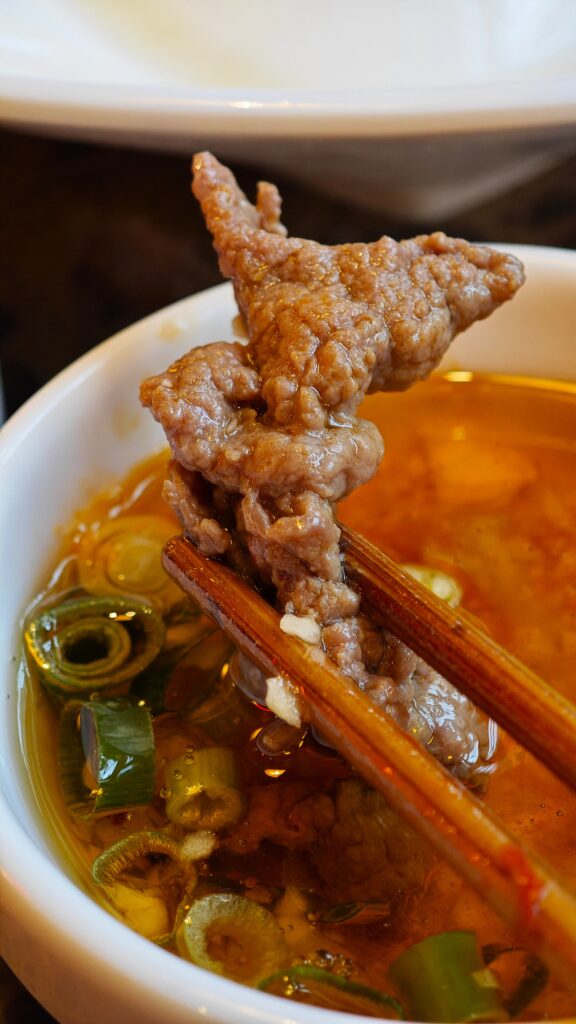
If you’re looking for the juicy, melt-in-your-mouth beef, the Tender Beef (嫩牛肉) is a good choice. Sourced from the sirloin or flank, this cut is naturally tender with a silky-smooth texture.

Get ready for incredible bounciness and silky softness! The beef is expertly tenderized—pounded and marinated with starch and egg whites—for that signature springy, velvety texture. Unlike Diao Long, this one remains succulent even if left in the broth a little longer, never turning tough or chewy.
It also works well with all broths and dips. Personally, though, we prefer mala spicy broth for its bold heat and irresistible kick, and the sesame paste dip for that nutty, creamy depth.
Cook until there’s no red left—a few swishes in the broth should be enough to bring out its bouncy, juicy perfection!
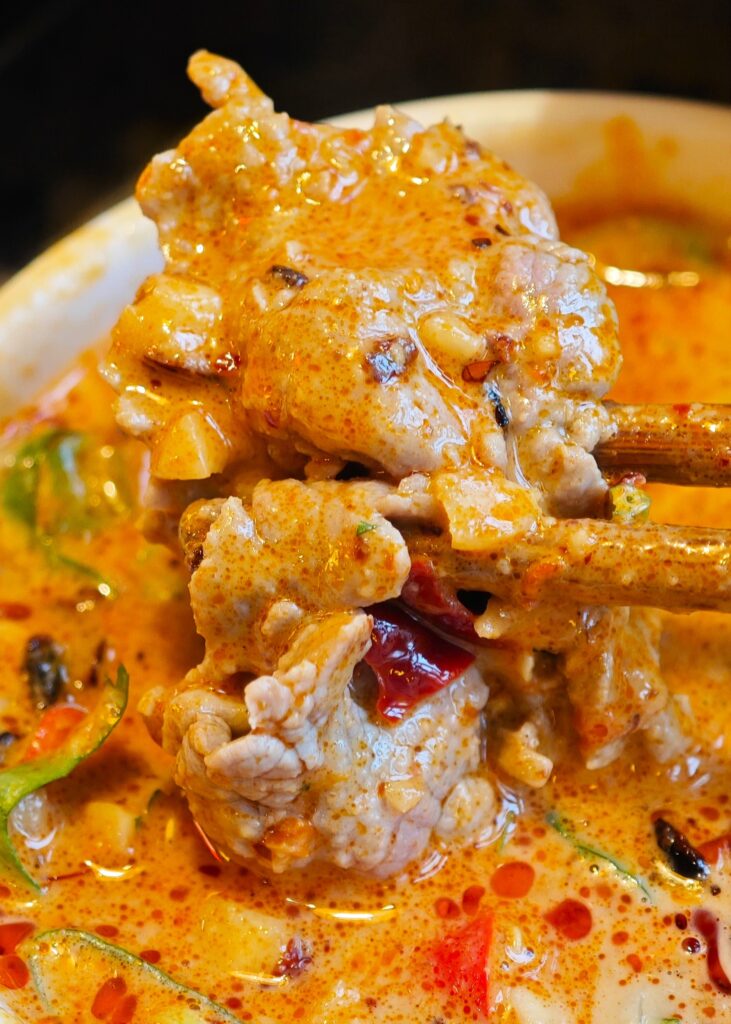
If you love deep, rich lamb flavors, then Lamb Spine (羊蝎子) is for you. This cut comes from the spinal bones of the lamb, packed with tender meat, marrow, and a good amount of fat.
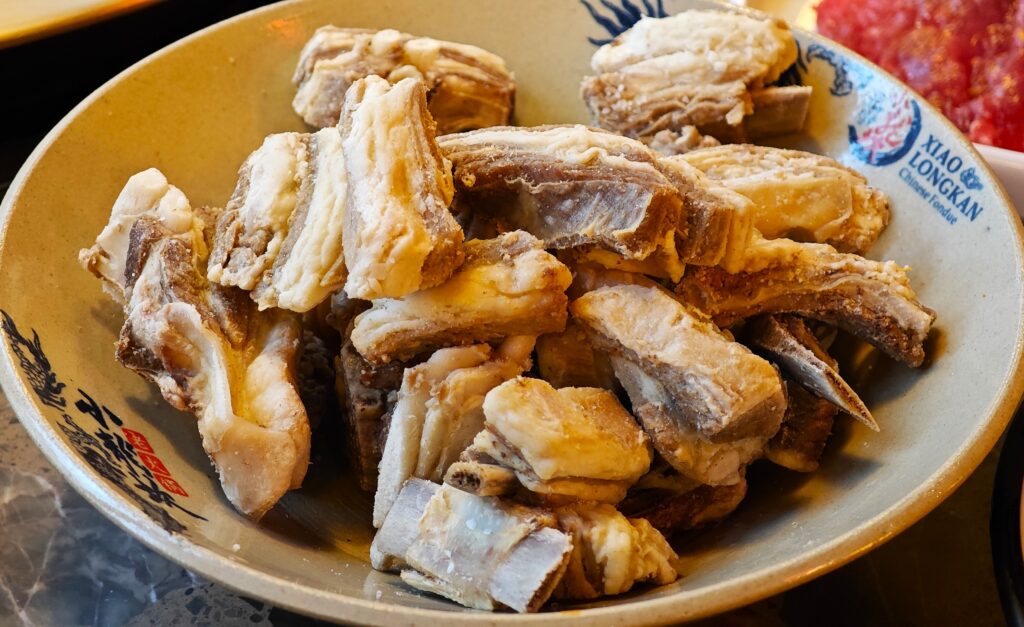
In China, Yang Xie Zi (or lamb spine) is hugely popular, especially in colder months. Traditionally enjoyed in hot pot or braised stews, it’s prized for its deep, intense lamb aroma and the pleasure of eating meat straight off the bone. The bone marrow inside melts into the broth, adding unparalleled richness and depth—a key reason why many Chinese put it in from the very beginning to let its flavor infuse the soup.
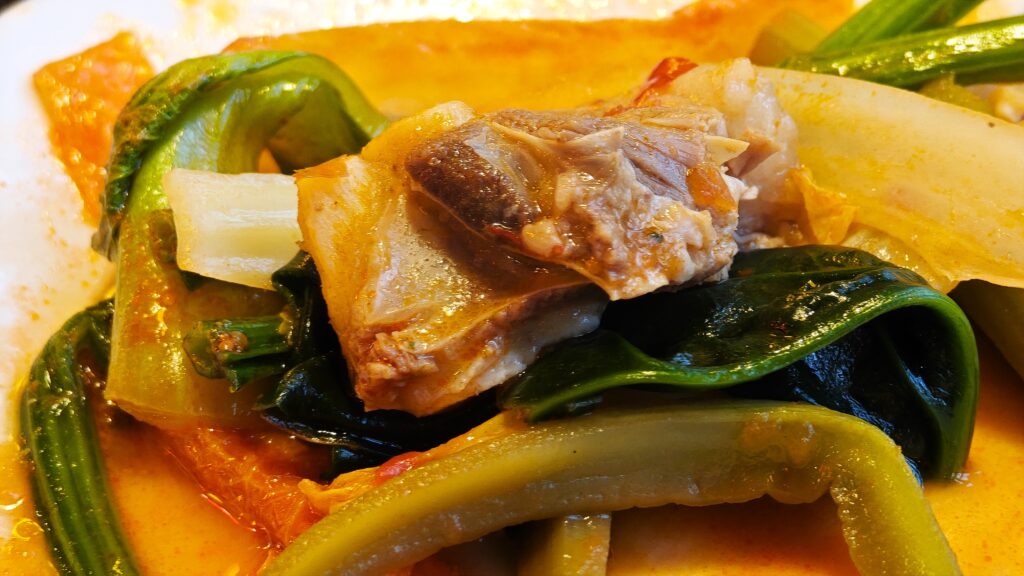
Compared to regular lamb meat, lamb spine has an even stronger, gamier taste with a silky, fatty richness. The flavor is bold and unfiltered. So if you like its robust, meaty character, we recommend keeping it simple—no strong-flavored broths or overpowering dips. The sesame oil with garlic will be just fine, or no sauce at all for the most authentic taste.
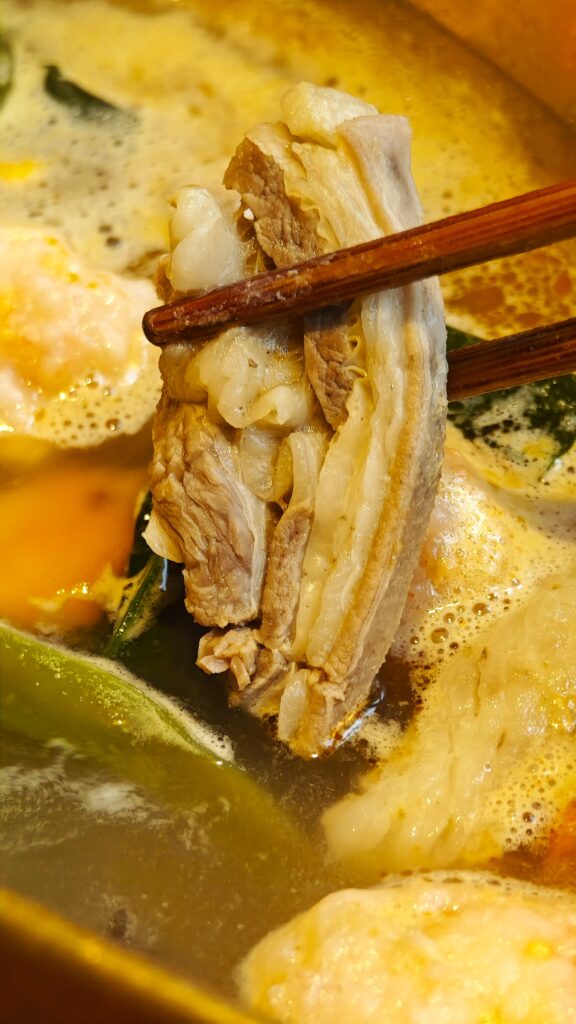
XiaoLongKan serves up a huge variety of fresh veggies – from leafy greens, earthy mushrooms, to crispy root vegetables. The selection includes spinach, pak choi, tomatoes, spring sprouts, chrysanthemum(茼蒿), setang, lotus root, winter melon, Chinese kohlrabi (莴笋) and all kinds of mushrooms and tofu. If you’re feeling indecisive, you can opt for a veggie platter with a mix of wood ear mushrooms, sweet potatoes, pak choi, Chinese cabbage (大白菜), and spinach.
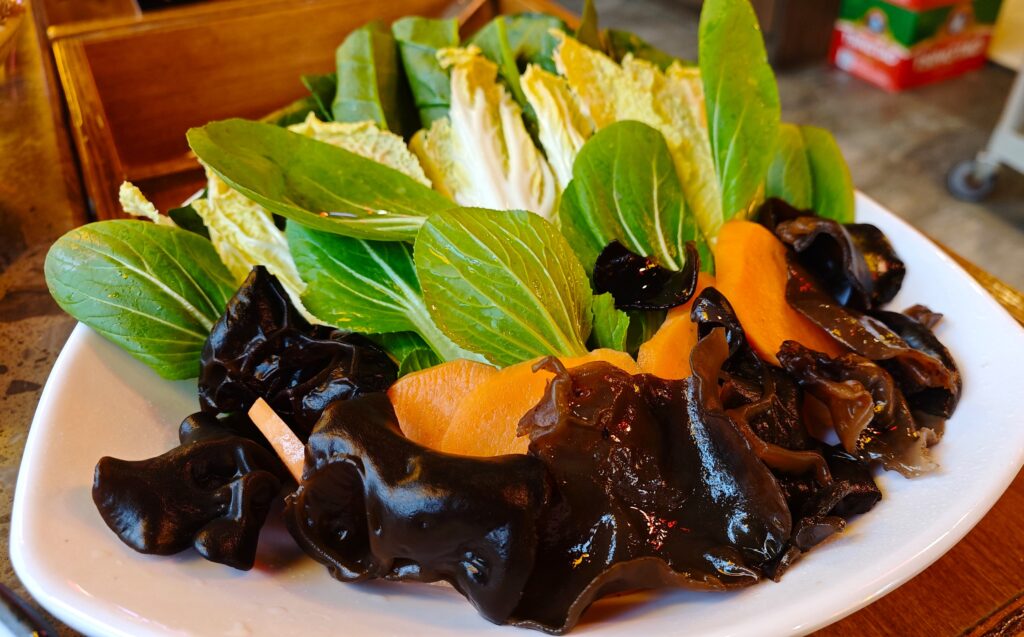
A word of advice—vegetables tend to absorb the heat and spice quickly, so when cooked in the Mala spicy broth, they may become quite intense and fiery. Therefore, we recommend using the milder Tomato or Pork Bone broths. The Tomato broth gives them a rich, savory sweetness, while the Pork Bone broth imparts a heaty depth that enriches the light vegetable taste. It’s perfect, if you want fresher and more balanced veggie flavor to smooth your palate and stomach.
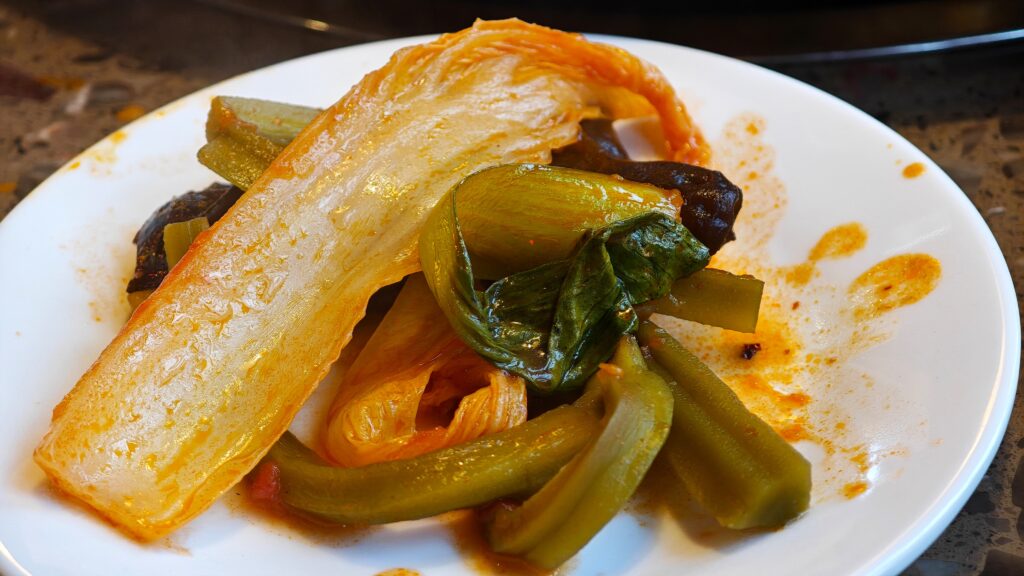
If you’re a true hot pot fan, you can’t miss Cao Yuan Fa Mao Du (草原发毛肚), a beef tripe revered as hot pot treasure. In Sichuan, there are even hot pot restaurants dedicated entirely to this dish!
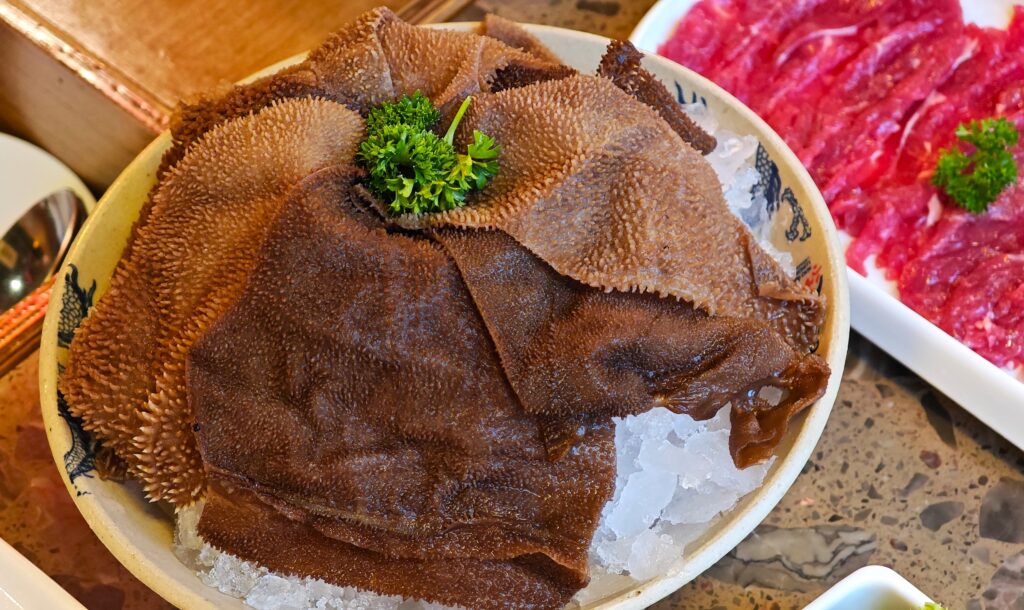
The term Cao Yuan(草原) suggests that this Mao Du comes from cattle raised in the grasslands, which are known for producing high-quality beef due to the cows’ natural diet.
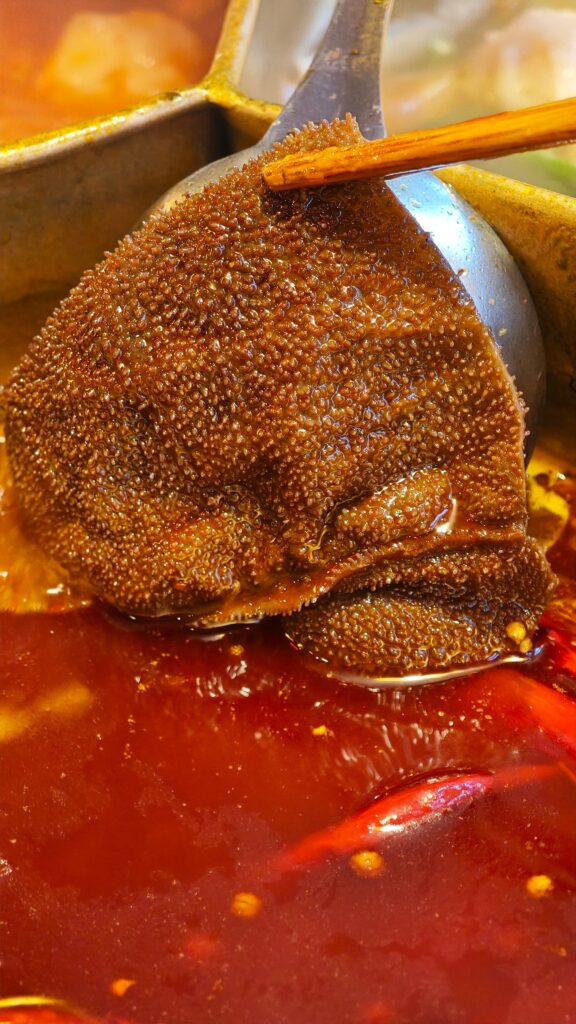
The pieces served at XiaoLongKan are carefully prepared. They are thin, with a deep dark, brownish color and distinct ridges—those little spikes give the tripe its signature crunch. Its firm texture holds up perfectly in the hot pot, never getting too soft, but absorbing the broth wonderfully.
The Mao Du here pairs best with the Mala Spicy Broth – where its mild, slightly sweet and earthy flavor becomes the ideal canvas for the fiery and numbing spice (麻辣). When dipped in rich sesame paste sauce, its crispy, chewy texture, lusciously coated in a creamy, nutty savoriness, brings out the full, rich, umami-packed flavor with just the right amount of heat – simply sensational!
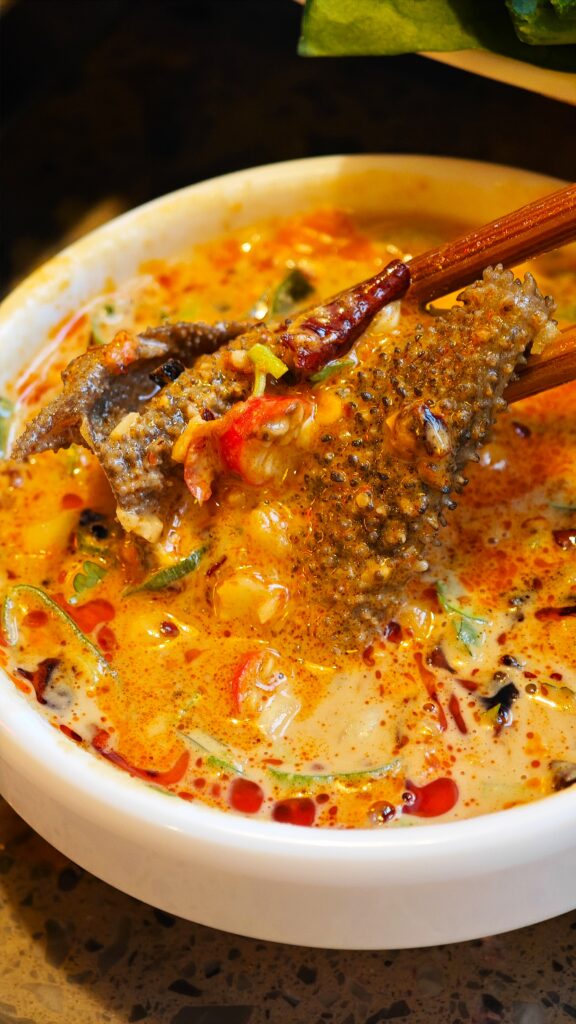
If you’re an adventurous foodie, you can give Da Dao Yao Pian (大刀腰片) a try. This dish features pork kidney slices, expertly cut with a broad knife (hence the name “Da Dao,” meaning “big knife”). Pork kidneys are one of the most prized organ meats in Chinese cuisine, known for their tender, springy texture and distinctive umami taste.
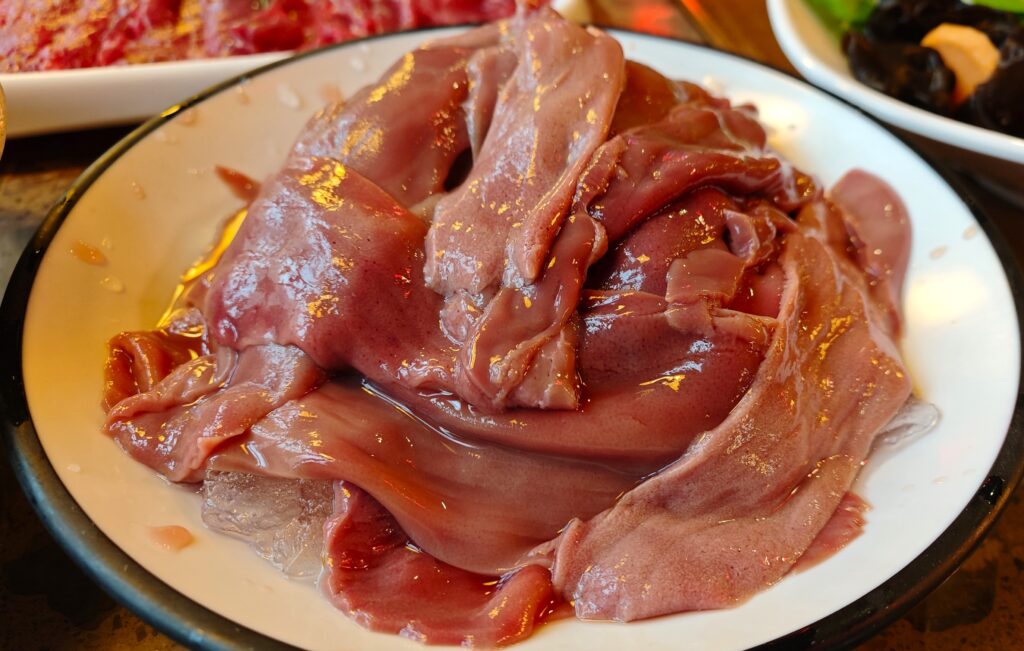
At XiaoLongKan, the pork kidney slices are incredibly fresh, smooth, and thinly sliced. They cook quickly in the hot pot while keeping their signature soft and bouncy bite. Their mild yet slightly mineral-rich flavor makes them a perfect match for spicy, aromatic broths, like the Mala Spicy Broth—it infuses the kidney with a bold, fiery kick while balancing its natural taste, for a deep, umami -packed bite.
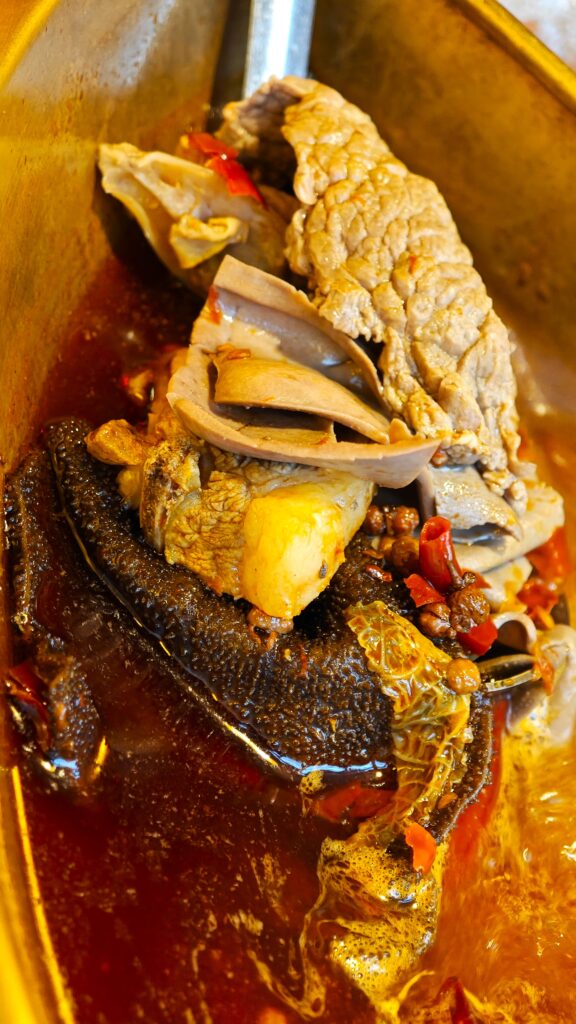
While kidney dishes aren’t for everyone, man appreciate their tenderness and depth of flavor. Some may find the initial taste slightly gamey, but when cooked in intensely flavorful broth, that richness turns into something bold, aromatic, and utterly delicious. Dipping it in garlicky sesame sauce adds a layer of nutty smoothness – its silky, tender texture with bold, layered flavor is just remarkable!
Beyond its flavor, pork kidney is also high in protein, low in fat, and rich in essential vitamins and minerals like iron, zinc, and B vitamins – nutrients that boost energy and contribute to its widespread popularity.
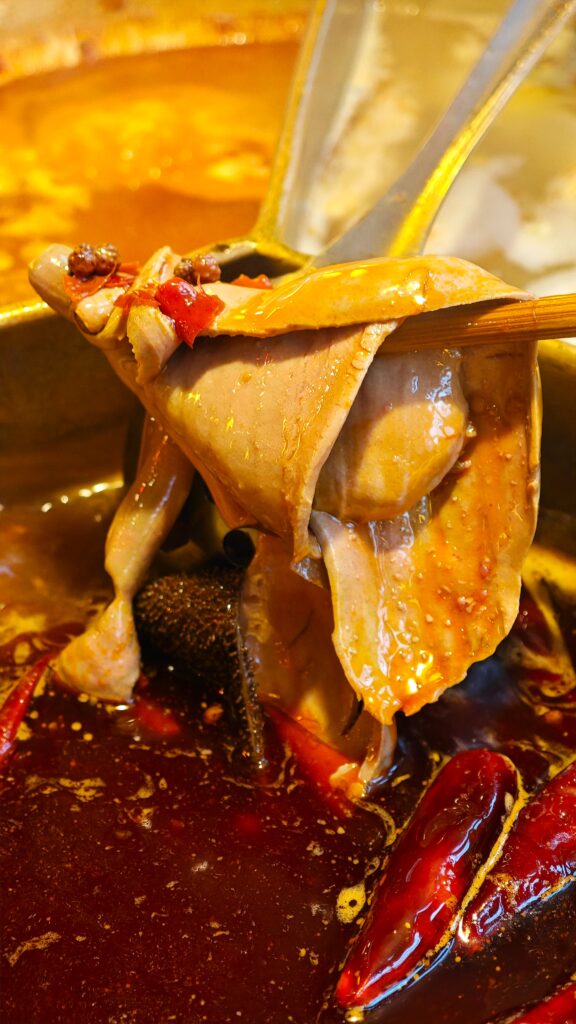
Gan Gong Cai (干贡菜) is a rare find in overseas Chinese restaurants. Originating from China, Gong Cai (贡菜) is a type of cultivated stem lettuce, known for its natural crispness and mild, slightly earthy, and subtly sweet taste. This dried vegetable, rehydrated before cooking, has a firm, crunchy texture that holds up well in any hot pot broth.
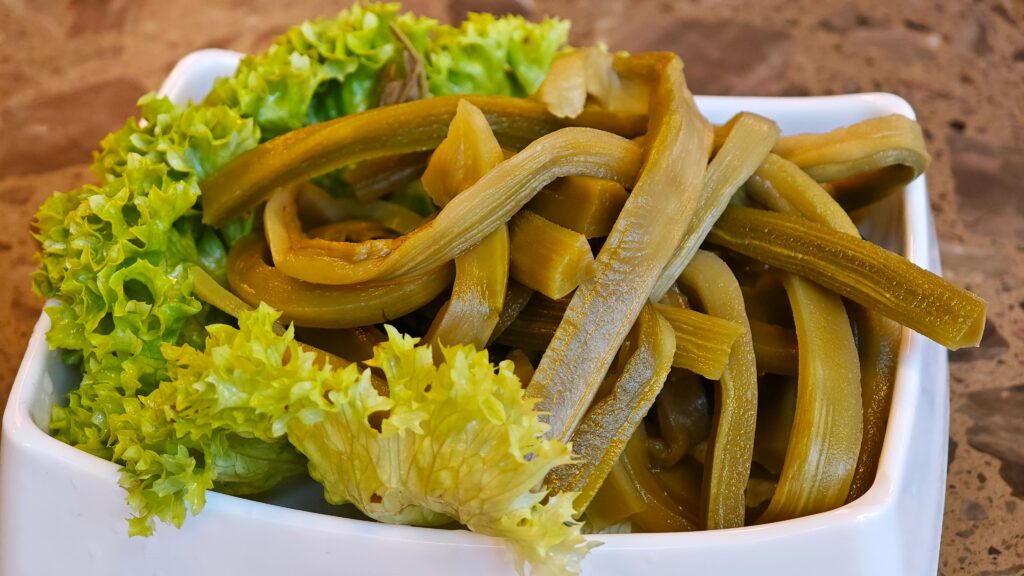
Its fresh crispness contrasts nicely with the heat of the Mala Spicy broth, delivering a crunchy, flavorful bite. The Tomato broth gives it a slightly tangy note while keeping its natural freshness. When simmered in the Pork Bone broth, Gong Cai takes on a comforting, delicate umami, but its natural light flavor remains in the foreground.
This veggie is a nutrition powerhouse. it’s low in calories, high in dietary fiber, and rich in vitamins A and C, which support immunity and skin health. It also contains calcium and iron, making it a popular, nutritious addition to any hot pot meal.
If you’re a seafood lover, Crab Roe & Fish Roe Shrimp Ball (蟹黄鱼籽虾球) is a must-try. Among XiaoLongKan’s impressive selection of meatballs—cilantro pork balls, beef balls, fish balls and shrimp balls—this delicacy is a rare find, and an absolute game-changer.

The shrimp paste, crafted from finely minced shrimp meat, has an intensely rich, naturally sweet shrimp flavor. The texture is tender yet springy, balanced between smoothness and a satisfying meaty bite.
Then comes the fish roe blended into the shrimp paste. These tiny pearls deliver a delicate, salty burst, adding a popping sensation.
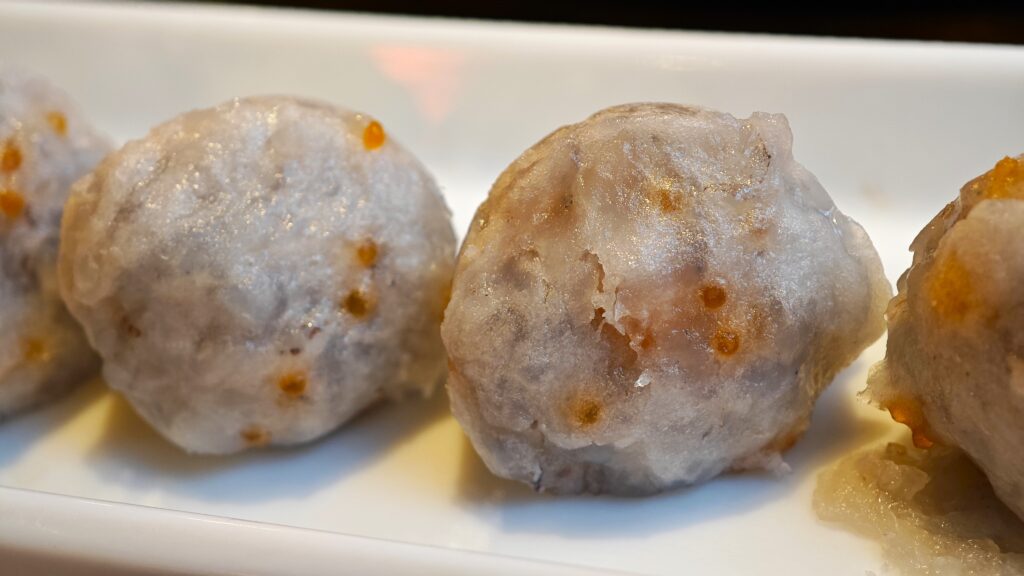
Just when you think it can’t get any better, you reach the crab roe filling, generously packed inside. Crab roe (蟹黄) is the most prized and luxurious part of a crab, for its decadent taste and high nutritional value – rich in protein and omega-3 fatty acids.
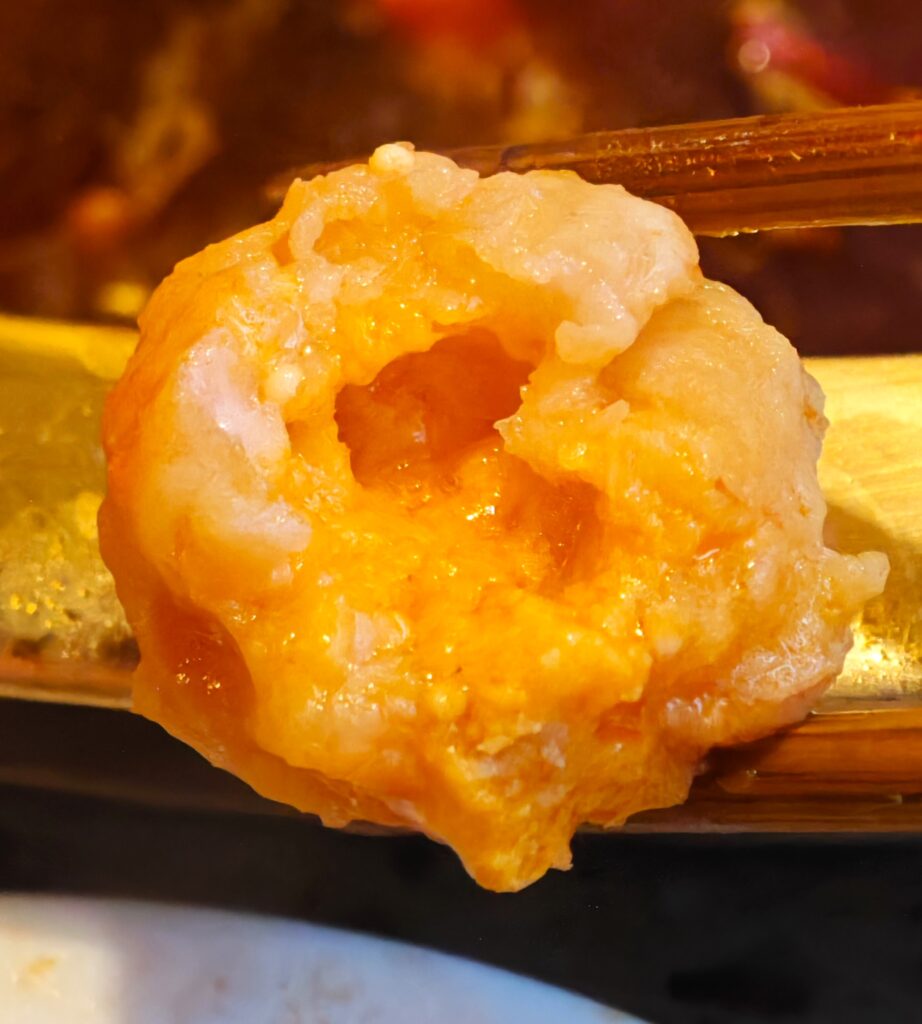
The moment you bite in, the roe melts into an explosion of deep, umami-rich oceanic goodness, coating your palate with its buttery, slightly sweet, and subtly briny essence.
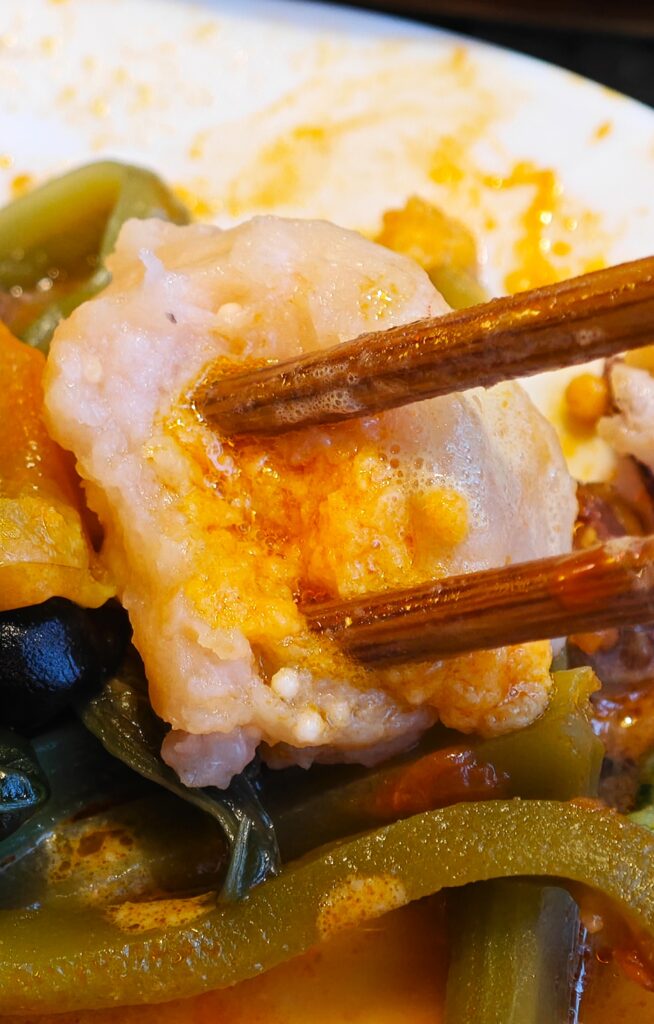
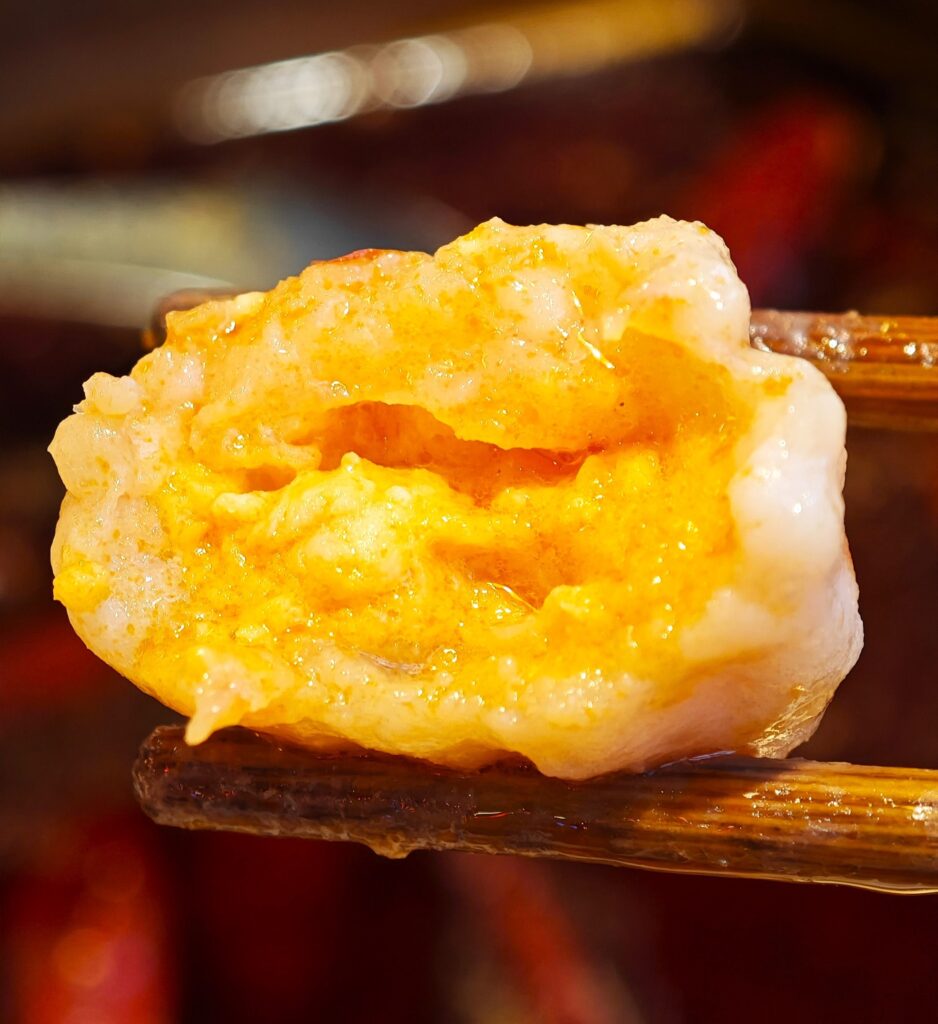
This dish is so naturally flavorsome and exquisite that no dipping sauce is needed—just drop it into a mildly flavored broth like pork bone soup or tomato broth, let it cook for about 10 min, and prepare for an almost divine sensory indulgence.
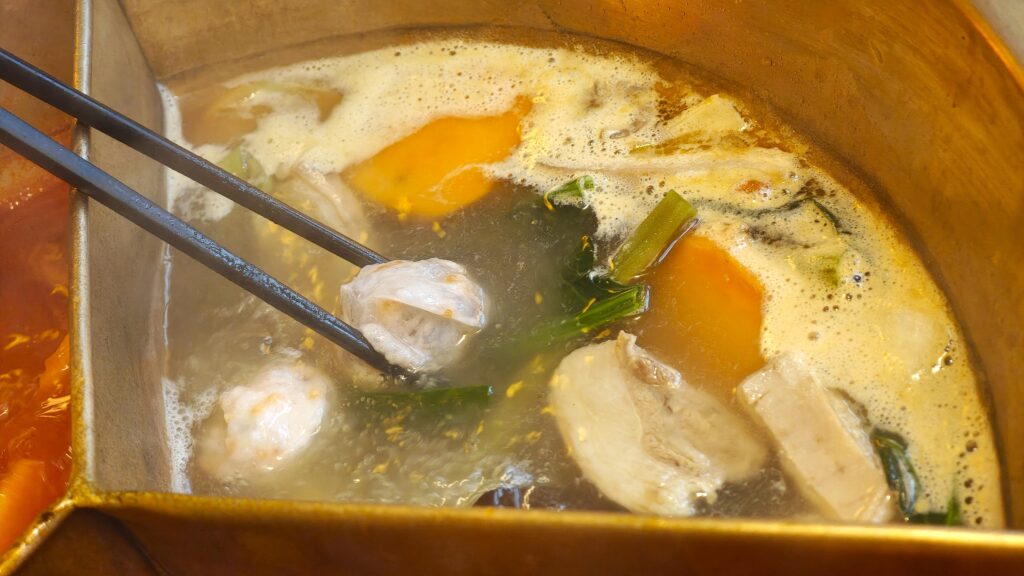
At XiaoLongKan, long chopsticks are provided for shared use across the table. These extended chopsticks help keep your hands safe from any splashes of the bubbling, hot broth, while the shorter ones are reserved for your personal use.
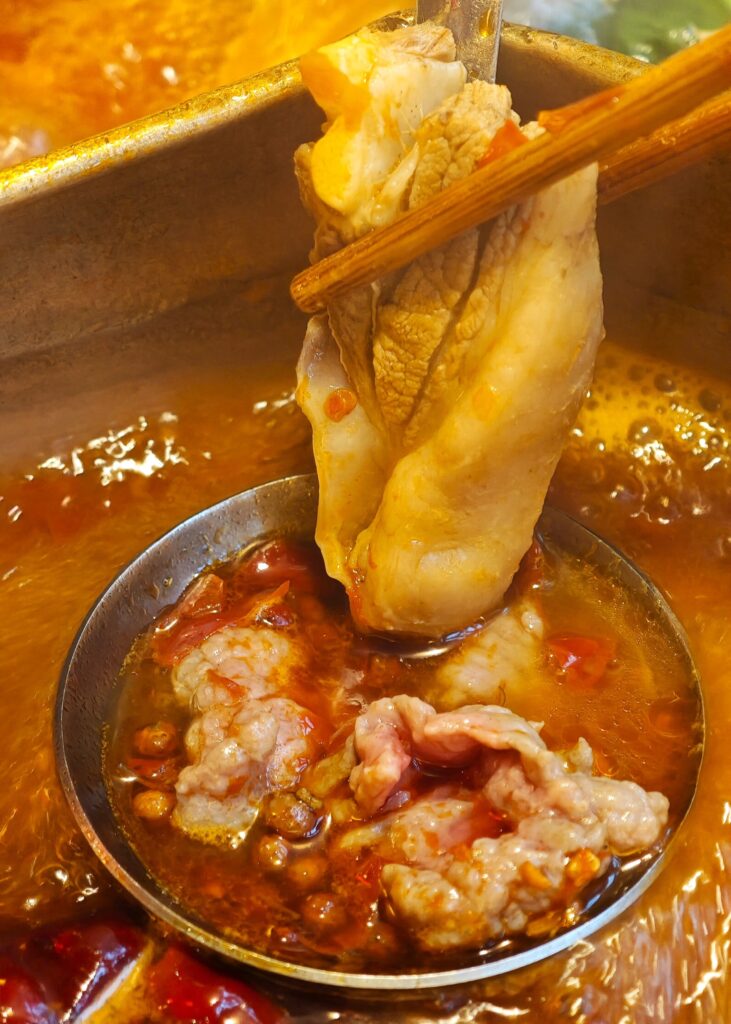
Like many other hot pot spots, XiaoLongKan also offers thinly sliced meat rolls. While these are fine, we recommend opting for the fresh cuts first, as they really stand out. The dishes we’ve highlighted here come with little to no marinade. If you like an extra kick, you can try the beef cuts marinated with fresh green and red chilies—a dish similar to what we’ve featured at another hot pot place in Frankfurt. And for even greater indulgence, XiaoLongKan also offers juicy Wagyu, the premium beef from Japan known for its rich marbling and melt-in-your-mouth texture.
Hot pot is an immersive experience of Chinese tradition and flavor, one of the most beloved activities during Chinese New Year. The sizzling sounds, the fragrant steam, and the joy of dipping fresh ingredients into bubbling broth create an atmosphere of togetherness that’s not just about eating, but about connecting.
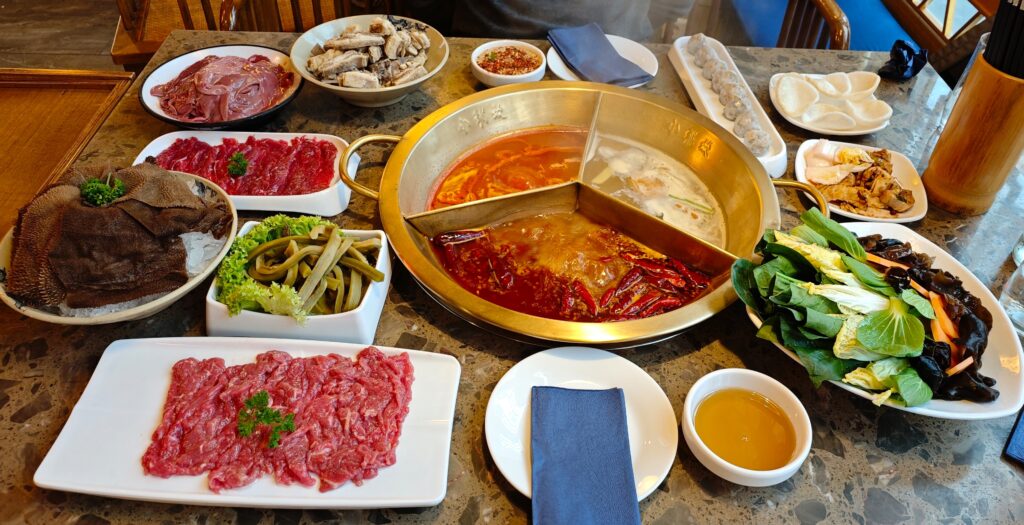
Before we finish, we’d like to mention a few alternatives to cure your hot pot cravings. If you’re in the mood for a quieter meal but still crave hot pot flavors without the hassle of cooking, try Malatang (麻辣烫)—a flavorful soup served with your choice of ingredients in a personal portion. Or go for Dried-Stirred Maocai (干拌冒菜), a “dry version” of hot pot with all the bold, spicy flavors. For something unique, there’s also a restaurant in Frankfurt that combines BBQ and hot pot, offering both grilled and simmered delights in one meal!

